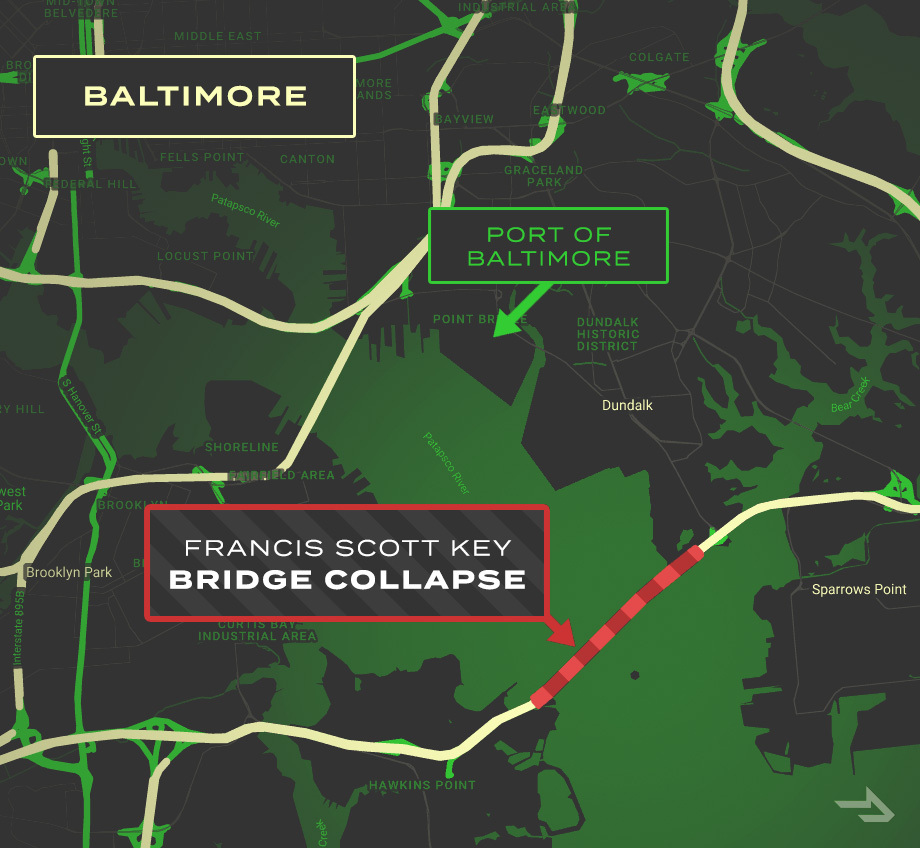Baltimore Bridge Collapse: Supply Chain Impact on Ocean & OTR Freight
Early in the morning of March 26, a container ship leaving the Port of Baltimore, MD struck the Francis Scott Key Bridge over the Patapsco River, causing it to collapse.
As of this publication, six people are currently missing from the disaster, and the Port of Baltimore is closed indefinitely.
The closure of the port and the loss of a major arterial highway through the city will have significant impacts for shippers with freight moving in and out of Baltimore and carriers who operate in the region.
How Did the Francis Scott Key Bridge Collapse?
Just prior to 1:30 a.m. EDT, a containership called the Dali radioed a mayday to shore and reported a loss of power. The Dali had just left the Port of Baltimore with a full load of freight containers and was on its way to Sri Lanka.
Livestream video of the incident shows the ship’s lights flicker on and off several times before it veers off course and strikes one of the bridge’s main support pillars.
Upon impact, the entire 1.6-mile bridge collapsed into the Patapsco River, one of the main waterways feeding the Chesapeake Bay, within a matter of seconds.
Maryland Governor Wes Moore indicated that the ship’s warning allowed traffic to be halted onto the bridge, limiting the potential loss of life from the incident.
What Does This Mean for Supply Chains?
Due to the ongoing rescue effort and presence of debris in the water of the Patapsco River, the Port of Baltimore is closed indefinitely. It is unclear how long it will take to open a navigable channel through the river and allow water traffic to resume.
The closure is causing oceangoing traffic to reroute to other major Mid-Atlantic ports. The Seagirt Marine Terminal at the Port of Baltimore indicates that there were 81 vessels scheduled to import between March 26 and April 9; the majority are currently rerouting to New York and Norfok, VA.
While we don’t anticipate over-the-road capacity will be materially impacted, traffic through Baltimore will be. The Key Bridge was one of three major crossings of the Patapsco River; all OTR traffic will now need to reroute through the Fort McHenry Tunnel and Harbor Tunnel to cross the river, or to circumvent the city with a lengthier alternative route.
This will likely cause traffic delays for all OTR freight, and it will create greater challenges for oversized loads moving through the city, as both tunnels have strict size restrictions (14’6” in height and 11’ in width for the Fort McHenry Tunnel,13’6” in height and 8’ in width for the Harbor Tunnel).
How Should Shippers Respond?
If you’re a shipper moving freight into or out of Baltimore (either over the road or through the port), here are some tips for how to respond going forward:
- Allow more time for any freight traveling over the road through Baltimore. Traffic through the two tunnels over the Patapsco will likely be severe. Seek alternative routes if possible.
- Communicate early and often with your providers if you have impacted shipments. The more notice you can give your 3PL or carrier that you have freight impacted by the disaster, the better they’ll be able to help you explore alternatives for getting it to its destination on time.
- Set realistic expectations with your customers. Let them know delivery may be affected, especially if your oceangoing freight has been moved to a different East Coast port.
We Can Help With Shifting Drayage Needs
If your drayage and port freight needs have changed in light of the Port of Baltimore’s closure, reach out to us to help you adjust.
Contact your Coyote rep if you have any questions about how these events may impact you or reach out to our shipping specialists below to start planning a new solution.





